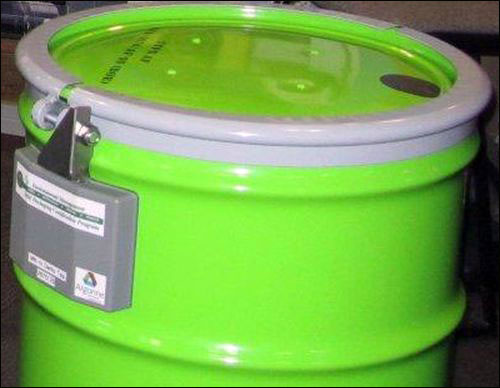The U.S. Department of Energy‘s Argonne National Laboratory (ANL) is piloting a new radio frequency identification system in its effort to track barrels containing sensitive nuclear materials within the DOE’s storage facilities. The agency’s goal is to monitor the barrels’ status, 24/7, and issue real-time alerts in the event of any abnormal conditions. The RFID solution, with includes key components provided by Evigia Systems, is a second-generation solution utilizing ANL’s existing ARG-US RFID-based software. The system is intended to provide a flexible platform that can accommodate a radiation dosimeter (a sensor for measuring gamma radiation exposure), and offer future expandability for additional sensors.
Evigia supplied a modified version of its EV3 RFID tag, a battery-powered device compliant with the ISO 18000-7 standard. The tag, the company reports, has a battery lifespan of more than 10 years and a form factor adequate to accommodate radiation sensors, as well as temperature, humidity and shock detection. The modified tag transmits data only when queried by a reader, but can also immediately send an alert if the sensor detects an unacceptable change in conditions, such as a rise or drop in radiation levels.
The integration of a radiation sensor with Evigia’s wireless platform was carried out jointly by Argonne and Evigia engineers. Evigia also provided technical support to Argonne engineers for the final integration with the DOE’s ARG-US RFID system.
Argonne National Laboratory, located just outside Chicago, is one of the DOE’s largest national research laboratories, employing more than 1,250 scientists and engineers to solve challenges related to energy, the environment and national security. For ANL, the new ARG-US tag is another step in a sustained project to provide wireless technology that can help protect the public from the threat of leaks or thefts of nuclear materials (see U.S. Department of Energy Employs RFID to Safeguard Country and 2011 RFID Journal Award Winner: Most Innovative Use of RFID-Tracking and Monitoring the Deadliest Cache). Even as the new system is being tested by ANL, Evigia is currently in discussions with other agencies and utilities to provide the EV3 system to protect the public and workers from potentially disastrous leaks from containers of hazardous materials, or from such operations as the production of nuclear energy.
Argonne National Laboratory has been testing RFID systems for the DOE’s Office of Packaging, Transportation and Environmental Management since 2008, in order to determine which wireless automated solutions could monitor the status of barrels containing sensitive nuclear materials 24/7, thereby enabling the lab to know if there were an abnormal event or security breach involving the barrels. During previous pilots, the agency utilized a proprietary active RFID tag—the ST-676, from Savi.ANL chose the EV3 system for the new pilot, partly because Evigia’s solution complies with the ISO 18000-7 standard, which—since it is an open system—would allow the addition of other products, such as additional sensors, in the future. “To meet ANL’s needs, Evigia made changes to the EV3 sensing tag firmware,” explains Navid Yazdi, Evigia Systems’ CEO, “to enable the sending of alerts under specific circumstances, such as when a predetermined radiation level threshold was exceeded.” The pilot was launched in February 2012 at the DOE’s Savannah River Site, in South Carolina, and is slated to last until September of this year.
The Savannah River Site processes and stores nuclear materials in support of the United States’ national defense and nuclear non-proliferation efforts, and also develops and deploys technologies to treat nuclear and hazardous wastes left over from the Cold War. The SRS complex covers 310 square miles, bordering the Savannah River.
The ARG-US tags are bolted to a seal encircling the rim of metal barrels containing sensitive nuclear materials, allowing the tags to measure barrel-seal integrity, as well as temperature, humidity, shock and gamma radiation levels. Each tag stores sensor data until receiving a polling signal (programmable from minutes to hours) from one of Evigia’s EV3-AFI fixed RFID readers installed within the storage area in which the tags are located. In the event that any abnormal sensor reading is detected, the tag instantly issues an alert to the AFI reader. The tag has a read range of up to approximately 450 feet in a heavily metallic environment.
Each interrogator has an Ethernet connection to the agency’s back-end system, on which Argonne’s ARG-US software resides. Upon receiving a signal from a reader, the tag responds by transmitting its own unique identifier, along with a summary of the sensor readings and alerts. The tag also transmits a log of all sensor measurements performed since the previous transmission.The ARG-US software enables a user to receive data regarding the sensor readings associated with each barrel, and also stores information pertaining to each barrel’s location. Because barrels may be stacked three high, the ARG-US software is programmed to show each one’s location in three dimensions, on the basis of its unique ID number. The barrels are stored according to a predetermined map generated for the purpose of identifying barrel storage sites. In this way, management can receive an alert (via a text message, mobile phone call or e-mail) from the system if a tag detects an unusual sensor reading, and thus pinpoint the specific barrel and its exact location within the storage room, based on information transmitted by the tag. According to the lab, analysis of the data received to date indicates satisfactory and reliable performance of the dosimeter-enabled RFID system.
In addition, the solution can be used in transit, as shown in several applications and demonstrations. The reader mounted within the transport vehicle can receive read data at specified intervals, and forward that information to the ARG-US system via a satellite communication connection.
In cooperation with Argonne, Evigia Systems expects to further enhance tag function by incorporating neutron detectors, hydrogen gas sensors, cameras and other devices, such as a loop seal, which includes a fiber optic cable that would wrap around a barrel pallet. With a loop seal in place, the tag would be able to detect any breakage or significant bending of the fiber optic that may have occurred due to tampering.
“The ARG-US system with EV3 technology will enable users to not only better protect the public and workers with enhanced safety and security, but it will also reduce the need to manually check the status of barrels, which could cost several thousands of dollars per inspection,” says Yung Liu, Argonne’s manager of the DOE ARG-US RFID program. Reducing the need for manual inspection, Liu adds, also minimizes workers’ radiation exposure. Evigia and ANL are presently exploring the possibility of licensing ANL’s technology in order to make broad commercial solutions available for the tracking of nuclear and hazardous materials, and are targeting government and commercial customers.



